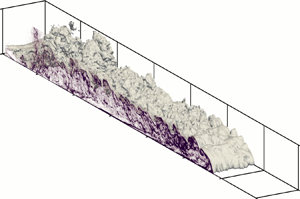Published online by Cambridge University Press: 20 August 2020

The present study aims to provide a statistical analysis of turbulence in the mixing layer of a lock-exchange gravity current propagating over a 2 % slope based on large eddy simulation using a Boussinesq code. The statistics are calculated from the ensemble and spanwise averaging of 200 simulations for two time steps corresponding to the initial constant velocity slumping phase and the decelerating inertial phase. The overall energy balance and structure of the mixing layer are weakly influenced by the propagation time following the lock release. Thereby, streamwise dominated turbulence is produced by the positive buoyancy flux and subsequently converted into averaged flow through energy backscatter in the nose, whereas the current's interface takes the structure of a stratified mixing layer unstable to Kelvin–Helmholtz instabilities in the rear of the head. The dependency of the current head/body structure on the evolution of the turbulence kinetic energy (TKE) along the mixing layer is also investigated. The transition from the head to the body is associated with a peak of TKE and the flux Richardson number exceeding the stability criterion  $Ri_f = 0.2$. It is furthermore observed that the turbulence intensity in all three spatial directions stabilises to satisfy
$Ri_f = 0.2$. It is furthermore observed that the turbulence intensity in all three spatial directions stabilises to satisfy  $\langle u'u' \rangle = 2 \langle v'v' \rangle = 2 \langle w'w' \rangle$, where
$\langle u'u' \rangle = 2 \langle v'v' \rangle = 2 \langle w'w' \rangle$, where  $u', v' \ \text{and} \ w'$ are respectively the streamwise, spanwise and vertical turbulent perturbations of velocity. Finally, a region of statistically stationary TKE is identified once the gradient Richardson number plateaus to a value dependent on the current's propagation approximately 5.5 lock heights backward from the front, where the depth-averaged TKE budget reduces to the balance between the contributions due to shear (P), buoyancy (B) and viscous dissipation
$u', v' \ \text{and} \ w'$ are respectively the streamwise, spanwise and vertical turbulent perturbations of velocity. Finally, a region of statistically stationary TKE is identified once the gradient Richardson number plateaus to a value dependent on the current's propagation approximately 5.5 lock heights backward from the front, where the depth-averaged TKE budget reduces to the balance between the contributions due to shear (P), buoyancy (B) and viscous dissipation  $(\varepsilon)$ as
$(\varepsilon)$ as  $\langle P \rangle _d + \langle B \rangle _d - \langle \varepsilon \rangle _d \approx 0$.
$\langle P \rangle _d + \langle B \rangle _d - \langle \varepsilon \rangle _d \approx 0$.